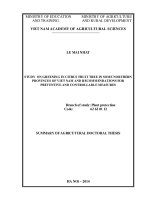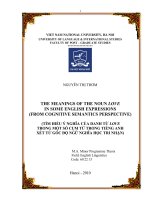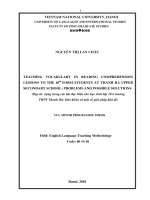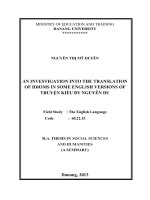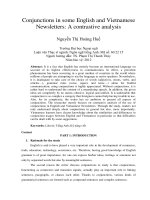Integrated teaching approaches in some english lessons of english book 10,11,12
Bạn đang xem bản rút gọn của tài liệu. Xem và tải ngay bản đầy đủ của tài liệu tại đây (2.34 MB, 18 trang )
SỞ GIÁO DỤC VÀ ĐÀO TẠO
TRƯỜNG THPT NGA SƠN
SÁNG KIẾN KINH NGHIỆM
INTEGRATED TEACHING APPROACHES
IN SOME ENGLISH LESSONS OF ENGLISH BOOK 10,11,12
Người thực hiện
: Nguyễn Thị Lan
Chức vụ
: Giáo viên
SKKN môn
: Tiếng Anh
THANH HÓA NĂM 2018
1
TABLE OF CONTENTS
PART I. INTRODUCTION………………………………………………. .
1. Reasons for choosing the research…………………………………………...3
2. Aims of the research………………………………………………………….3
3. Object of the research………………………………………………………...3
4. Research methods………………………………………………………….....3
PART II. CONTENTS………………………………………………..………. .4
1. Rationale……………………………………………………………….… ....4
2. Practical basis………………………………………………………….…… 4
3. Integrated teaching approaches………………………………………….…...4
3.1. Integration within one subject alone……………………………...…..…..5
3.1.1.Integration of four skills……………………………………………..…5
3.1.2. Integration of knowledge..…………………………………………...…8
3.2. Integration between two or more subjects…….………………………....9
PART III. CONCLUSION …………………………………………………....16
PART IV. REFERENCES………………………………………………..........17
2
PART I. INTRODUCTION
1. Reasons for choosing the research.
If teaching is an art, then the colour palette is the knowledge mix. - Dr.
Whitfield Green.
As you know, nowadays, integration approach has been taking special attention
and encouraged to apply into teaching and learning, but in fact, integrated teaching
subject has been under discussion off and on for the last half-century, with a
resurgence occurring over the past decade. The "explosion" of knowledge, the
increase of state mandates related to myriad issues, fragmented teaching schedules,
concerns about curriculum relevancy, and a lack of connections and relationships
among disciplines have all been cited as reasons for a move towards an curriculum
integration.
Integrated teaching approach's like getting a new pair of lenses that make
teaching a lot more exciting and help us look forward into the next century because
this approach brings the positive effects:
* Integrated approach helps students apply skills.
* An integrated knowledge base leads to faster retrieval of information. Multiple
perspectives lead to a more integrated knowledge base.
* Integrated approach encourages depth and breadth in learning. Integrated
curriculum promotes positive attitudes in students.
* Integrated approach provides for more quality time for curriculum exploration.
2. Aims of the research.
The author carried out this study to share some significant experiences and
integrated teaching methods with an attempt to make a small contribution to the
already enriched teaching methods in the hope of helping our students indulge in
learning as well as reach the goal of learning English in particular and of education in
general.
3. Object of the research.
This research focuses on integrated teaching approaches in English textbook for the
students of three blocks.
4. Research methods.
- Study the documents about integration curriculum.
- Find out some lessons being able to apply integration curriculum.
- Discuss in English group.
- Teach and attend some integrated lessons to draw out experiences.
3
PART II. CONTENTS
1. Rationale.
In our time, the movement toward a global economy and international
connections, as well as the rapid changes in technology, are pushing education toward
integration. The ability to make connections, to solve problems by looking at multiple
perspectives, and to incorporate information from different fields, will be an essential
ingredient for success in the future.
Another rationale for curriculum integration finds its basis in the commonsense
wisdom of teachers, who are coping with an increased body of knowledge, large
classes, and many mandates related to everything from individual awareness to
national tasks. When all of these requirements are added to the traditional body of
knowledge for which teachers feel responsible, integration is seen as one way to meet
both the needs of the students and the requirements of the state. The integration of
curricular areas and concepts, skills, knowledge allows teachers to assist students as
they prepare for the next century.
To integrate means to coordinate, blend, or bring together separate parts into
a functioning, unified, and harmonious whole. Curricular integration assists
students to identify the links, not only between ideas and processes within a single
field, but also between ideas and processes, in separate fields, and in the world
outside of school.
2. Practical basis
It is undeniable that Vietnamese high school students are overwhelmed with
their school work. They have to learn a lot of subjects which have the same part of
knowledge but taught in many different areas. In English, each unit is seperated into
four skills and teachers often only focus on one skill, but almost all of lessons teachers
can redesign to combine skills together, especially all 4 skills, because most practical
communicative situations requires more than one skill or when teaching new
knowledge that is developed on the foundation of old knowledge, many teachers only
teach new one, but not revise old one.
It is taken for granted, apparently, that in time students will see for themselves
how things fit together. Unfortunately, the reality of the situation is that they tend to
learn what we teach. If we teach connectedness and integration, they learn that. If we
teach separation and discontinuity, that is what they learn. To suppose otherwise would
be incongruous. So the teacher should use integration approach.
3. Integrated teaching approaches:
3.1. Within one subject alone
3.1.1. Four Skill integration.
3.1.1.1. Literature review.
4
a. Why to integrate the language skills
- When we communicate, we often use more than a single language skill. On the
telephone, for instance, we listen and speak-maybe we also write down a message and
read over what we have written.
- Integrated approach helps to build new knowledge and skills on to what students
already know and can do. So, if students are able to read a short story, this skill will
help them to write their own story.
- Also, integrating the skills allows you to build in more variety into the lesson because
the range of activities will be wider. Instead of just having listening, the students can
have speaking, reading and writing practice. This can raise their motivation to learn
English.
- Above all, integrating the skills means that you are working at the level of realistic
communication, which provides all-round development of communicative competence
in English.
b. How to integrate the four skills
- The easiest form of integration is within the same medium (either oral or
written), from receptive to productive skills.
Receptive Skill
Productive Skill
Oral Medium
listening
speaking
Written Medium
reading
writing
- The second kind is complex integration. This involves constructing a series of
activities that use a variety of skills. However, it’s important to make sure that
one activity is closely linked thematically to the next one.
c. The implications of integrating the four skills for teaching
Integration of the four skills is concerned with realistic communication. This
means that we are teaching at the discourse level, not just at the level of sentences or
individual words and phrases. Discourse is a whole unit of communicative text, either
spoken or written.However, integrating the four language skills can be demanding of
the teacher:
We need to have a good understanding of discourse, and to be able to use textbooks
flexibly.
- This can also be time-consuming, requiring a lot of preparation.
- Another limitation is the problem of designing suitable materials that take account
of students’ different skill levels. The four skills tend to develop at a different pace:
receptive skills are stronger than productive skills, for example.
This means that teachers have to be skilful is selecting or designing integrated
activities for their students.
3.1.1.2. Examples
5
Example 1: English 11. Unit 2. Part D. Writing a personal letter about a past
experience.
*Activity 1. Ss practise asking and answer about their unforgettable experience with
the following questions .(aim at practising speaking skill)
- What is your unforgettable experience?
- When did it happen?
- Where did it happen?
- How did it happen?
- Who was involved?
- How did it affect you?
*Activity 2. Sudents(ss) listen to a sample letter writing about Nam’s unforgettable
experience( stimulate ss’letter hobby) and then answer T’s questions( aim at helping ss
practise listening skill)
A sample letter:
Dear Long,
How have you been doing? Have you got any plan for the coming school break?
Perhaps I will go to see my grandparents in the countryside. I haven’t seen them since
my last school holiday.
Let me tell you about my last summer vacation at my grandparents’. It was
almost a year ago and was one of my most unforgettable experiences.
My grandparents live in a small village in Trung Khanh. There is a large river
at the back of their house where I often do swimming every afternoon when I spend my
vacation with them.
One day when I was swimming with some of my friends, I suddenly caught a
cold. I felt so dizzy and was too weak to continue swimming, so I started to sink. I
thought I was going to drown but I couldn’t call out for help because I was too tired
and terrified. Luckily, one of my friends saw that and shouted for help. Immediately,
another friend who swims the best among us swam towards me and tried to pull me up.
Then other friends swam towards us to help him push me in.. My ljfe was finally saved.
Now recalling the moment I thought I was going to die, I understand how
precious life is. This event definitely taught me to appreciate my life.
What about you? Have you got any unforgettable holiday that you would like to share
with me?
See you soon.
Yours friendly,
Nam
Answer the questions:
- What happened to Nam?- He was going to drown
- When did it happen? - It happened a year ago.
6
- Where did it happen? - It happened in the river at the back of his
grandparents’ house.
- How did it happen?- One day when I was swimming with some of my
friends, I suddenly caught a cold. I felt so dizzy and was too weak to
continue swimming, so I started to sink. I thought I was going to
drown …
- Who was involved? - His friends.
- How did it affect him?
- He understand how precious life is and
taught him to appriciate his life
(Ss can not answer all the questions but they will be curious to read this letter in
handout.)
*Activity 3. Ask ss to read the sample letter in handout again to draw out the form of
an informal letter( what parts?) and how to organize information.(aim at practising
reading skill)
The form of an informal letter:
+ Greeting
+Opening
+ Contents
+ Conclusion
+ Signature
The ordering:
+ what happened?
+ when it happened?
+ where it happened?
+ how it happened?
+ how it affect you?
*Activity 4. Writing a letter telling about one of your most memorable experience:
( aim at practising writing skill)
Example 2. English 11. Unit 4. VOLUNTEER WORK. Part A. Reading
*Activity 1. Warm up. Ss work in pairs to ask and answer some questions.( speaking
skill).
- Have you done anything to help the disadvantaged and handicapped children or old
and sick people?
- What do you do to help them?
- Do you like doing that work ? why?
- How often do you do ?
Leading to new lesson: Volunteer work
*Activity 2. Read the passage and then do the tasks in textbook( reading skill)
*Activity 3. Write a short paragraph to summarise the passage and read out in front of
class( writing skill)
*Activity 4. Listen and comment or correct mistakes.(listening skill)
7
3.1.2. Knowledge integration
3.1.2.1. Literature review
Knowledge integration has been studied as the process of incorporating new
information into a body of existing knowledge. This process involves determining how
the new information and the existing knowledge interact, how existing knowledge
should be modified to accommodate the new information, and how the new
information should be modified in light of the existing knowledge.
Why we need integrate old knowledge into new knowledge? Because in text
book 11 and 12 there are many new grammar, content, topic, tasks…relating to old
theory in textbook 10, 11 and most of our ss learn before forget about later, so we
should revise them in order to help ss apprehend new knowledge easily.
In the following part, I will give some examples.
3.1.2.2. Examples
Example 1: English 12. Unit 13. Part E. Grammar: Double comparison.
*Task 1. Reviewing the form of comparative adjectives/ adverbs. (existing
knowledge)
More + Adj/ adv(long)
Adj/adv(short) + er.
Special adjectives/ adverbs:
- Good/well → better
- Bad/badly→ worse
- Much/many→more
- little→less
- far/farly→farther/further
Adjectives having two sounds and ending with “ y” are considered
as short adjectives:
- happy→ happier
- lazy→ lazier
*Task 2. Teaching double comparison.( new knowledge)
The + comparative, the + comparative
Comparative + and + comparative
Example 2. English 11. Unit 15. Part B. Speaking: making questions and answer
about the important events in space exploration.
*Task1. Reviewing the structure of the common questions and answers in
English.( existing knowledge)
Yes/ No question:
Auxiliary verb + S + V…? – Yes , S + aux.v/ No, S + aux.v +not
Wh-questions:
8
Wh-question + aux.v + S +V….? – S + V+…
Wh-question + V+….? – S + V+…
*Task 2. Basing on the paragraph at page 170 in textbook, the teacher ask
and ss answer.(put them into practice)
*Task 3. Ss work in pairs to make question and aswer about the important events
in space exploration.(ss use flexibly the structure of the questions in multiform
situations -new knowledge)
3.2.Between two or more subjects.
3.2.1. Literature review.
Integrating curriculum in the classroom includes combining different subject
areas and then teaching them in relation to a singular theme or an idea. An integrated
curriculum utilizes three different types of approaches of integration including the
multidisciplinary approach, the interdisciplinary approach and the transdisciplinary
approach.
Multidisciplinary Integration
Multidisciplinary approaches focus primarily on the disciplines. Teachers who
use this approach organize standards from the disciplines around a theme. Figure 1.1
shows the relationship of different subjects to each other and to a common theme.
There are many different ways to create multidisciplinary curriculum, and they tend to
differ in the level of intensity of the integration effort. The following descriptions
outline different approaches to the multidisciplinary perspective.
Figure 1.1. The Multidisciplinary Approach
Interdisciplinary Integration
In this approach to integration, teachers organize the curriculum around common
learnings across disciplines. They chunk together the common learnings embedded in
the disciplines to emphasize interdisciplinary skills and concepts. The disciplines are
9
identifiable, but they assume less importance than in the multidisciplinary approach.
Figure 1.2 illustrates the interdisciplinary approach.
Figure 1.2. The Interdisciplinary Approach
Transdisciplinary Integration
Use the transdisciplinary integration approach by organizing the curriculum around
student questions and concerns. Transdisciplinary integration is done through projectbased learning which involves allowing the students to tackle a problem. Project-based
learning allows students to make connections among different subjects by solving the
problem and answering open-ended questions
Figure 1.3. Transdisciplinary Approach
According to Chard (1998), planning project-based curriculum involves three
steps:
Teachers and students select a topic of study based on student interests,
curriculum standards, and local resources.
The teacher finds out what the students already know and helps them
generate questions to explore. The teacher also provides resources for students
and opportunities to work in the field.
10
Students share their work with others in a culminating activity. Students
display the results of their exploration and review and evaluate the project.
3.2.2. Examples:
Multidisciplinary Integration
Exemple 1. English 11. Unit 7. World population. Part D. Writing: writing a paragraph
to describe information in the pie chart.( integrated with geography)
Warm up. SS base on information about the favourite games of students given in
handout to draw a pie chart.( SS use geographic knowledge to represent data by
the pie chart)
Handout:
- The rate among the favourite games of ss is not the same
- Cricket has the largest students. It accounts for 30%.
- Basketball has more than double the students of tennis( with 25% and
13% respectively).
- Next is soccer, which occupied 20% in all.
- 12% of favourite games of ss belongs to chess and it ranks last.
Expected answer:
Pre-writing: Reading data in the pie chart at page 86 in English book 11.(SS use
their geographic knowledge to read data in the pie chart in English)
Ss use their geographic knowledge and suggested information in handout
of warm up to describe the chart or T can help them by asking some questions
such as:
11
- What is the topic of the pie chart?
- How did it distribute among region?
- Which continent has more than double the population of the
whole world?
- Which continent ranks second?
- Which region had the most population?
- Which region is the least populated in all?
- ….
Example 2. English 12. Unit 11. BOOKS. Part D. Writing: Describing a book.(
integrated with literature)
Pre-writing. Ss base on their literary knowledge of a report on the book
(How many parts dose a report have and what they are? What is the function
of every part? or In each part, what we should write? )
Expected answer?
a/ General introduction
(what is the tittle of the book? Who is the author? What type of book is it/
why did you choose that particular book?)
b/ Summary of the book’s content
(where is the book set?/ what is the main theme of the story?/ who are the
main characters?/ what is the plot of the story?)
c/ Conclusion
(what is your opinion of the book?/ would you recommend it to others)
12
Interdisciplinary integration
Example 3. English 11. Unit 10. Nature in danger, Unit 11. Sources of energy, Unit 10.
Endangered species (English 12)…
- Through such units, we join to educate ss the awareness of protecting nature, energy,
wildlife species…( integrated with civic education)
Example 4. English book 10. Unit 16. Historical places. Part A. reading. (integrated
with history)
Warm up.
Show some pictures of Van Mieu-Quoc Tu Giam(VMQTG) and ask ss to
talk about what they know about its history?( SS reconstitute their historic
knowledge about VMQTG in English)
In the autumn of the year Canh Tuat, the second year of
Than Vu (1070), in the 8th lunar month, during the reign of King Lý Thánh Tông,
the Văn Miếu was built.
The statues of Confucius were carved and 72 other statues of
Confucian scholars were painted. Ceremonies were dedicated to them in each of
the four seasons. The Crown Princes studied here."
- In 1076, Vietnam's first university, the "Quốc Tử Giám" or Imperial Academy, was
established within the temple during the reign of Lý Nhân Tông to educate
Vietnam's bureaucrats, nobles, royalty, and other members of the elite. The university
remained open from 1076 to 1779.
…
Ask ss to study the passage in textbook to gain more information about VMQTG
today.
Multidisciplinary and interdisciplinary integration
Example 5. English 12. Unit 16. Part D. Writing: Write a letter to your pen pal,
David,recommending a significant place to visit .(integrated with geography, history,
literature and civic education)
*Activity 1. Ss complete the sample letter in textbook and draw out the text mode of a
letter(what parts?)(integrated with litterature)
Outline:
Date
Salutation
Body
- Location
- natural features
13
- places to visit
- food
- people
Closing
*Activity 2. Ss watch some pictures of Hoi An on screen and practise asking and
answering about it before writing a letter to recommend to their pen pal.
( integrated with history and geography )
14
*Activity 3. Ss write a letter to recommend about Hoi An for their penpal, David,
to visit( introducing a historical place to an foreigner, which means that students
are being educated about the awareness of conserving and promoting cultural
heritage and national identity) (integrated with civic education)
Transdisciplinary integration
15
Example 6: English 11. Unit 10. Nature in danger. Part B. Speaking(Ss have to use
knowledge of many subjects to tackle the tasks ). For instance:
*Activity 1. Causes of nature in danger:
- Burning forests and cutting down tree( using biological knowledge to explain)
- Using fertilizers and pesticides for cultivation( chemical knowledge)
- Discharging chemical pollutants into environment.( chemical knowledge)
- Killing endangered animals for fur, skin, food( social knowledge)
…
PART III. CONCLUSION
Do you wonder why it is important to integrate curriculum? Think about how
much you could learn in a classroom where you learn math, science and reading all
in one lesson or teaching a theme-based unit that focuses on cultural diversity and
incorporates core content area topics. When I taught through an integrated
curriculum, my students showed higher signs of retention at an increased rate than
when an integrated curriculum was not implemented. The reason for this is because
they were able to more closely relate to content and make real-world connections
in integrated curriculum approaches.
Students not only connect and create more real world connections in integrated
classrooms, but they are also more actively engaged. Creating an integrated
curriculum means that teachers are charged with having to create challenging, fun,
meaningful tasks that help students connect to information. Creating a solar system
unit that also requires oral language development and practice, reading
comprehension skills and mathematics, can engage students far more than just a
lesson on the solar system alone. Integration helps to achieve retention and
engagement in classrooms, which yields higher mastery of content standards.
One final key benefit of an integrated curriculum is the ability for students to see
skills multiple times. Instead of teaching comprehension strategies in just reading,
teaching those strategies across multiple disciplines can give students an
opportunity to see and implement it more often. The repetition of the skills being
taught creates a higher level of understanding and retention of information for
students in the classroom.
With what I have suggested above, I hope that teachers and students will be
more interested in this field and will find this task less and less hard. I have tried
my best in this study with an aim to share my modest experience with all
colleagues. However, mistakes and shortcomings are unavoidable. So any remarks
will be warmly welcomed. The educational benefits gained from applying these
activities.
16
I myself have applied the integration approaches to teach the students of all three
blocks in many lessons and have found considerable benefits as I write above.
I hope that this theme would be of some value to both teachers and students in
their language teaching and learning process.
I would like to thank.
The confirmation of the principle
Thanh Hoa, May 25th 2018
I promise not to have copied
Signature
Nguyễn Thị Lan
PART IV. REFERENCES
1.Goldbort, R.
"Literature, Science, and Liberal Education: Toward Integrative Studies." Teaching
English in the Two-Year College 18/2 (1991): 121-125.
2. Watkins, B.
"In Non-traditional, Interdisciplinary Study at Columbia College, Artists Get a Chance
to Broaden Their Horizons, Hone Creativity." The Chronicle of Higher Education 37/3
(1990): 17.
3.Britton, J.
Writing and Reading in the Classroom. Technical Report Number 8. Berkeley, CA:
Center for the Study of Writing, August 1987. (ED 287 169)
4.Brandt, R.
"On Interdisciplinary Curriculum: A Conversation with Heidi Hayes Jacobs."
Educational Leadership 49/2 (1991): 24-26.
5.Caine, R., and Caine, G.
Making Connections: Teaching and the Human Brain. Alexandria, VA: Association for
Supervision and Curriculum Development, 1991.
6.Dressel, P.
"The Meaning and Significance of Integration." In The Integration of Educational
Experiences, 57th Yearbook of the National Society for the Study of Education, edited
by Nelson B. Henry. Chicago: University of Chicago Press, 1958, 3-25.
7.Fogarty, R.
The Mindful School: How to Integrate the Curricula. Palatine, IL: Skylight Publishing,
Inc., 1991.
8.Schmidt, W.
17
Curriculum Integration: Its Use in Language Arts Instruction. Research
Series Number 140. East Lansing, MI: Institute for Research on Teaching, 1983. (ED
241 942)
9.Shoemaker, B.
"Integrative Education: A Curriculum for the Twenty-First Century." Oregon School
Study Council 33/2 (1989).
18

